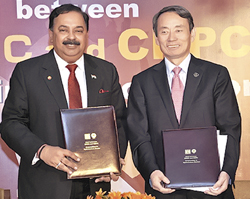Vol. 233 No. 8
OIL AND GAS IN THE CAPITALS
|
RAJ KANWAR, CONTRIBUTING EDITOR, SOUTH ASIA
|
Asia’s tiger and lion on a global E&P hunt
|

|
Facing an oil import bill of $140 billion in 2011-12, parallel exploration and production in both domestic and international arenas is a critical component of India’s energy policy. ONGC, India’s public sector E&P company, conducts its international operations through ONGC Videsh Ltd. At this time, OVL operates 33 projects in 15 countries. Ten of OVL’s properties are in the production stage, yielding 65 million boe during 2011-12.
To date, OVL has made a cumulative investment amounting to $14 billion in its foreign assets and, with a war chest of $8.8 billion at its disposal, is poised for a quantum jump over the next five years. Today, OVL contributes 15% to India’s oil and gas supply. OVL’s objective is to raise that contribution 45% to 259 million boe by 2030.
OVL had a humble beginning as Hydrocarbons India Ltd. (HIL) in 1965. It was during the tenure of Colonel S.P. Wahi, ONGC’s longest-serving chairman, that HIL was given a new avatar as OVL in 1989. It began by drilling two wells in Yemen and Egypt. However, OVL’s major breakthrough came in 1988, when it signed a contract for exploration and production in three offshore blocks in a joint venture with PetroVietnam and BP. ONGC then acquired the seismic vessel Sagar Sandhani and commenced a 2D survey in the allotted blocks of the South China Sea. Despite frequent, ferocious cyclones and hurricanes, the entire survey work of 6,400 line-km was covered successfully in seven voyages.
OVL’s efforts were eventually crowned in 1992, when it discovered LanTay and LomDo, two major gas fields. The success, unfortunately, brought in its wake legal disputes with BP, the result of which OVL was not allowed to develop the fields and had to relinquish 45% of its share to BP, wiping out much of its initial equity. But that was a lesson well learned. Once bitten, twice shy, OVL has proceeded with cautious due diligence, as much as possible in today’s complex international scenario.
Sudan had become a juicy target in the early 2000s. When Canada’s Talisman Energy wanted to opt out from the petroleum consortium operating there, ONGC quickly stepped into its shoes by investing $670 million for 25% equity in Greater Nile Petroleum Operating Company, which had as its partners CNPC (40%), Petronas (30%) and Sudan National Petroleum Corp (5%). It was ONGC and OVL that constructed the 741-km, 12-in. pipeline.
In 2001, OVL achieved greater momentum, when it acquired a 20% stake in the Sakhalin-1 project in the Far East region of Russia. Subsequently, in 2009, OVL acquired UK-listed Imperial Energy, with production and exploration assets in the Tomsk region of western Siberia at an investment of $ 2.1 billion. Other significant projects have been taken up in Venezuela and Kazakhstan. In mid-July, OVL reiterated its commitment to increase investments in several heavy oil projects in Venezuela, from $350 million to $3 billion.
With recent upheavals in the Middle East and Africa, OVL’s position is quite dicey in Sudan, where its operations have been adversely affected by the secession of South Sudan from the mother country. Likewise, its operations in Syria have been interrupted since December 2011 by the ongoing civil war there and the resultant sanctions imposed by the European Union.
ONGC’s CMD, Sudhir Vasudeva, who is also the chairman of OVL, has taken upon himself the task of giving an additional boost to OVL’s acquisition drive abroad and has focused on its manifold growth in the Group’s Composite Perspective Plan 2030, with a view to enhancing production six-fold from its overseas assets over the next 18 years.
The global business of acquiring oil and gas properties is highly competitive, with players from several countries bidding aggressively. China’s CNPC is amongst the most aggressive. Thus OVL, which is required to obtain prior approval of the government of India for high-value investments, is often left behind. ONGC’s latest coup is the landmark MoU it signed in June with CNPC, by far its biggest global rival. The historic agreement goes far beyond its rhetoric. It is all-inclusive, and brings within its orbit almost every facet of the oil industry, including construction of pipelines. A significant part of the agreement pertains to “extending areas of cooperation between the two entities to their joint participation in suitable hydrocarbon projects in other countries.”

|
An international E&P partnership: Sudhir Vasudeva, CMD, ONGC (left), and Jiang Jiemen, CNPC Chairman.
|
|
OVL’s Managing Director, D. K. Sarraf, is pleased with the agreement, “We should collaborate and bid together. There is no point in raising prices (in bidding for foreign assets),” he says. OVL is also conducting separate talks with Columbia’s Ecopetrol and Norway’s Statoil for cooperation in hydrocarbon exploration and development.
Chinese and Indian petroleum conglomerates could play a dominant role on the global stage, if the Chinese authorities and their official media do not harp upon controversial geopolitical issues like the South China Sea, where OVL has already temporarily abandoned its operations. It remains to be seen how effectively China’s tiger and India’s lion will cooperate in their hungry prowl for international E&P elephants. 
|
rkanwar_in@yahoo.co.uk / Raj Kanwar has been a journalist, a public relations and advertising professional and a businessman at different stages during the course of his 55-year career. He has weekly columns in Indian national dailies to his credit as well as the book Upstream India, an ONGC-commissioned history of the company.
|
|
|





